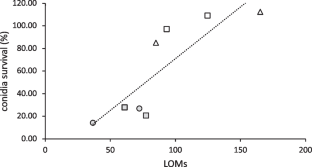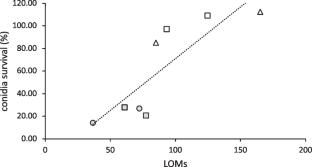Subterranean termites raise the alarm when their anti-fungal weapon falters
Abstract
Termicin is an anti-fungal defensin that is disseminated from termite salivary glands. The peptide appears to be critical for the elimination with mutual grooming (allogrooming) of pathogenic spores (conidia) that have attached to the insect cuticle. There has been a recent selective sweep for an advantageous variant of this peptide in the subterranean termite Reticulitermes flavipes. We tested the anti-mycotic activity of a recombinant termicin corresponding with this variant against the conidia of different Metarhizium fungal isolates from soil close to foraging R. flavipes workers. Termicin was most effective against isolates that had previously been shown to elicit a relatively weak alarm response, as indicated by brief bouts of rapid longitudinal oscillatory movement (LOM). These isolates that elicited weak alarm were also the deadliest apparently because the survival of termites exposed to the fungus depends on a strong social immune response (LOMs and allogrooming). The selective pressure for a single termicin variant may have been driven by the most dangerous isolates that elicit a weak behavioral response. The correlation between termicin anti-fungal activity and LOM suggests that pathogen-associated molecular patterns that affect termite recognition of conidial contamination and the onset of elevated allogrooming also affect the vulnerability of conidia to the disruption of their cell membranes by termicin.



 求助内容:
求助内容: 应助结果提醒方式:
应助结果提醒方式:


